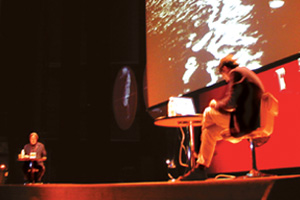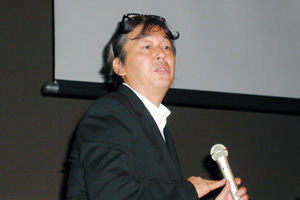|
|
 |
 |
 |
| Osamu Sakura (Japan), Toshiharu Itoh (Japan) |
 |
Life and Design, seeking insight
Osamu Sakura, from the School of Interdisciplinary Information Studies
of Tokyo University and the art historian and information scientist Toshiharu
Itoh engaged in a very thought provoking dialogue exploring how understandings
in life sciences could impact the design discourse.
True to the conference ambiguous heading <quality of information>/<jouhou
no bi> the presentation covered not only findings on how genetic information
is generated, stored and transformed but also speculations on biologically
encoded aesthetic principles of the evolution of forms.
Showing examples of the evolution of human artifacts through the centuries,
such as knife and fork, Osamu Sakura explained the more complex workings
in biology. The outlined relationships between environment, 'phenotypes'
and 'replicators', inspired the audience to re-think design processes
adopting this new vocabulary. Toshiharu Itoh pointed at the concept of
'super-systems' which claim that development patterns of life can be
equally found in the evolvement of cultures, societies, human dwellings,
and artifacts.
The realization, that evolution in genetic information directly affects
the genesis of form, lead to the concluding appeal to the two disciplines
represented on stage: life sciences need to expand their understanding
of 'quality', giving 'bi' equal importance. Designers should complement
their aesthetic competence with meta-design expertise, how to design
design. (AS)
|
 |
 |
 |
Simply Mass-produced Simplicity
Onuki Takuya talked through a thorough and well thought out presentation
of his work as a creative director of advertising commercials (CMs).
From his premise that most people today are not interested in advertisements
and that the average consumer is in fact not stupid, Takuya went on to
show his method of working around and with those beliefs. He follows
a set of six rules every time he approaches a project: stand out, be
conspicuous; be fresh and exciting; be simple and quickly understood;
advocate the image or 'color' of the client; work with products that
'sizzle'; and work with products in motion. Takuya believes in the power
of the first impression, and these six rules help him to attract, intrigue,
excite the 'gut feeling' of the consumer all within a few seconds of
time. To illustrate his point he showed several excellent, captivating
and amusing examples: Nissin's "Hungry? Cup Noodle" campaign,
Pepsi Cola's Pepsi Man, CC Lemon and the American animation 'The Simpsons',
Kirin Lager Beer, Toshimaen Amusement Park, Laforet Grand Bazaar In closing,
he shared more advice: Not being conspicuous makes you stand out. Make
it simple. Behind this concept lies a serious understanding of the situation,
but visualized in a simple manner. So simple it makes the commercial
appear simple. That is the secret to Takuya's success. (RZ)
|
 |
 |
 |
Writer:Kosuke Ikehata/Norimitsu Korekata/Junko Sakamoto/Nobuko Shimuta/Naoko Hasegawa/Osamu Hisanaga/Sakurako Muto/Naho Yoshioka/Maggie Hohle/Helmut Langer/Nicole Rechia/Andreas Schneider/Trysh Wahlig/Gitte Waldman/Robert Zolna
Photographer:Yoshimitsu Asai/Yasuhiko Katsuta/Fumihiko Mizutani |
 |
|

